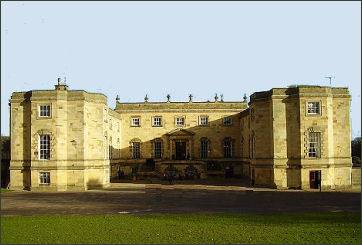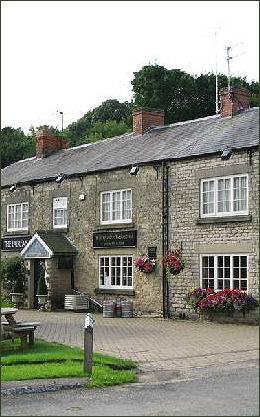Gilling East
OS grid reference:- SE 614 769
 Gilling East lies in the Howardian Hills and around two miles to the south of Oswaldkirk and 5 miles south of Helmsley. The village is situated on the main B1363 road between York and Helmsley.
Gilling East lies in the Howardian Hills and around two miles to the south of Oswaldkirk and 5 miles south of Helmsley. The village is situated on the main B1363 road between York and Helmsley.
Gilling Castle (pictured left) stands on a hill overlooking the village. It began life as a towerhouse built by Thomas Etton at some point in the fourteenth century. In 1349, due to the failure of the Ettons in the male line, the manor of Gilling passed to the Fairfax family.
 Thomas Fairfax claimed the property in 1489, his great grandson, Sir William Fairfax, who succeeded in 1571, undertook the rebuilding of the old fourteenth century house.
Thomas Fairfax claimed the property in 1489, his great grandson, Sir William Fairfax, who succeeded in 1571, undertook the rebuilding of the old fourteenth century house.
Building on top of the medieval walls and leaving the ground floor intact, he reconstructed the first and second floors, adding a staircase turret and an oriel window to the building at the back. The Great Chamber also dates from this time. The castle remained in the ownership of the Fairfax family until 1793. Most of the castle which we see in the present day dates from their period of occupancy. Today, the castle is home to St Martin's Ampleforth, the prep school for Ampleforth College.
The Gilling East Miniature Railway in the village is operated by the Ryedale Society of Model Engineers. The railway is multi-gauge (3½", 5" and 7¼") but the emphasis is on 5" gauge.
The RSME railway and club house share the site of the old school, now refurbished as Gilling East Village Hall, on Pottergate. The track is laid at ground level emulates main line practice in the construction and operation the railway.
The village pub, the Fairfax Arms,(pictured right) sits at the base of a hill which leads up the drive to Gilling Castle. it is a traditional country inn with a bar filled with character and atmosphere.The inn serves good food with a menu full of quality local produce and offers accomodation.
The Anglican church in the village is Holy Cross, a Grade I listed building. The medieval arcade dates back to about 1200. The chancel was added early in the fourteenth century, the southern arcade a little later. The tower dates back to the late fifteenth century. A tomb at the western end of the church is thought to be that of Sir Thomas Fairfax, a local land-lord, who died in 1828. Some restoration of the building took place in the Victorian era, this included the addition of the current organ chamber, which was installed in 1883. The east window, with its reticulated tracery, also dates to the nineteenth century.
